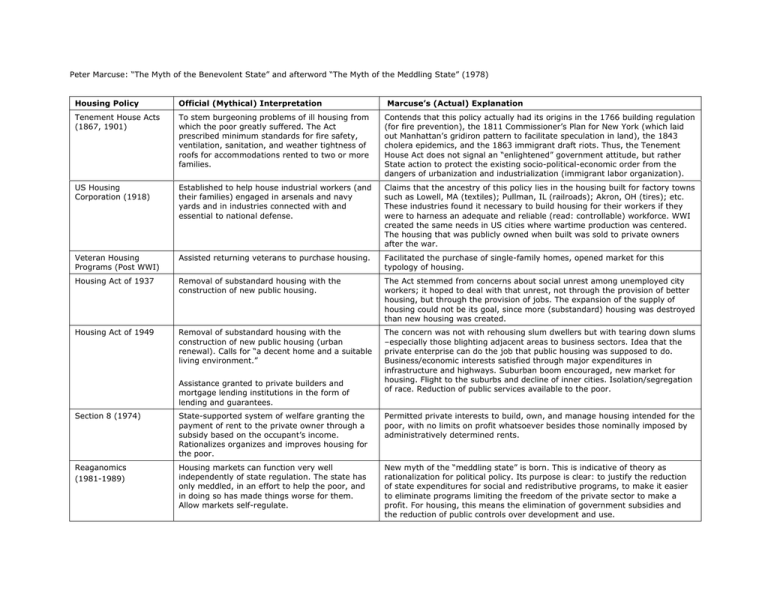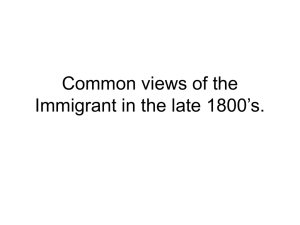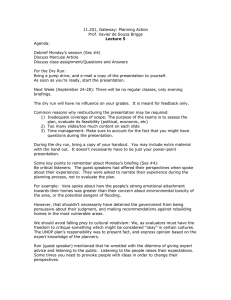Document 13630576
advertisement

Peter Marcuse: “The Myth of the Benevolent State” and afterword “The Myth of the Meddling State” (1978) Housing Policy Official (Mythical) Interpretation Tenement House Acts (1867, 1901) To stem burgeoning problems of ill housing from which the poor greatly suffered. The Act prescribed minimum standards for fire safety, ventilation, sanitation, and weather tightness of roofs for accommodations rented to two or more families. Contends that this policy actually had its origins in the 1766 building regulation (for fire prevention), the 1811 Commissioner’s Plan for New York (which laid out Manhattan’s gridiron pattern to facilitate speculation in land), the 1843 cholera epidemics, and the 1863 immigrant draft riots. Thus, the Tenement House Act does not signal an “enlightened” government attitude, but rather State action to protect the existing socio-political-economic order from the dangers of urbanization and industrialization (immigrant labor organization). US Housing Corporation (1918) Established to help house industrial workers (and their families) engaged in arsenals and navy yards and in industries connected with and essential to national defense. Claims that the ancestry of this policy lies in the housing built for factory towns such as Lowell, MA (textiles); Pullman, IL (railroads); Akron, OH (tires); etc. These industries found it necessary to build housing for their workers if they were to harness an adequate and reliable (read: controllable) workforce. WWI created the same needs in US cities where wartime production was centered. The housing that was publicly owned when built was sold to private owners after the war. Veteran Housing Programs (Post WWI) Assisted returning veterans to purchase housing. Facilitated the purchase of single-family homes, opened market for this typology of housing. Housing Act of 1937 Removal of substandard housing with the construction of new public housing. The Act stemmed from concerns about social unrest among unemployed city workers; it hoped to deal with that unrest, not through the provision of better housing, but through the provision of jobs. The expansion of the supply of housing could not be its goal, since more (substandard) housing was destroyed than new housing was created. Housing Act of 1949 Removal of substandard housing with the construction of new public housing (urban renewal). Calls for “a decent home and a suitable living environment.” The concern was not with rehousing slum dwellers but with tearing down slums –especially those blighting adjacent areas to business sectors. Idea that the private enterprise can do the job that public housing was supposed to do. Business/economic interests satisfied through major expenditures in infrastructure and highways. Suburban boom encouraged, new market for housing. Flight to the suburbs and decline of inner cities. Isolation/segregation of race. Reduction of public services available to the poor. Assistance granted to private builders and mortgage lending institutions in the form of lending and guarantees. Marcuse’s (Actual) Explanation Section 8 (1974) State-supported system of welfare granting the payment of rent to the private owner through a subsidy based on the occupant’s income. Rationalizes organizes and improves housing for the poor. Permitted private interests to build, own, and manage housing intended for the poor, with no limits on profit whatsoever besides those nominally imposed by administratively determined rents. Reaganomics (1981-1989) Housing markets can function very well independently of state regulation. The state has only meddled, in an effort to help the poor, and in doing so has made things worse for them. Allow markets self-regulate. New myth of the “meddling state” is born. This is indicative of theory as rationalization for political policy. Its purpose is clear: to justify the reduction of state expenditures for social and redistributive programs, to make it easier to eliminate programs limiting the freedom of the private sector to make a profit. For housing, this means the elimination of government subsidies and the reduction of public controls over development and use.








